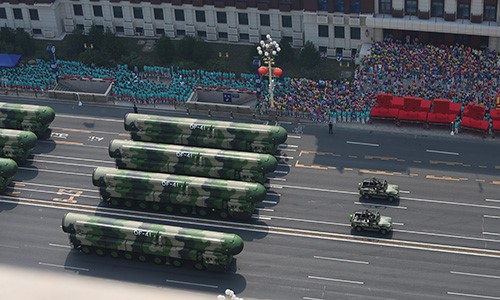The New York Analysis of Policy and Government concludes its presentation of the Department of Defense Report on China’s military power.
THE PLA’S GROWING GLOBAL PRESENCE
- CCP leaders believe that the PRC’s global activities, including the PLA’s growing global presence, are necessary to create an international environment conducive to China’s national rejuvenation.
- The CCP has tasked the PLA to develop the capability to project power outside China’s borders and immediate periphery to secure the PRC’s growing overseas interests and advance its foreign policy goals.
China’s Global Military Activities
- The PRC has increasingly determined that its armed forces should take a more active role in advancing its foreign policy goals. In 2020, a revision to the National Defense Law tasked the PLA with defending “overseas development interests,” further cementing the PLA’s involvement in the PRC’s global economic and diplomatic activities.
- As the PRC’s overseas interests have grown over the past two decades, the Party’s leaders have increasingly pushed the PLA to think about how it will develop the capabilities to operate beyond China’s borders and its immediate periphery to advance and defend these interests. This has led to the PRC’s greater willingness to use military coercion—and inducements—to advance its global security and development interests.
- In 2020, the PLA continued to normalize its presence overseas and build closer ties to foreign militaries, primarily through COVID-19 related aid.
PLA’s Overseas Basing and Access
- The PRC is seeking to establish a more robust overseas logistics and basing infrastructure to allow the PLA to project and sustain military power at greater distances.
- Beyond its base in Djibouti, the PRC is pursuing additional military facilities to support naval, air, ground, cyber, and space power projection. The PRC has likely considered a number of countries, including Cambodia, Myanmar, Thailand, Singapore, Indonesia, Pakistan, Sri Lanka, United Arab Emirates, Kenya, Seychelles, Tanzania, Angola, and Tajikistan, as locations for PLA facilities.
- A global PLA military logistics network and PLA military facilities could both interfere with U.S. military operations and support offensive operations against the United States as the PRC’s global military objectives evolve.
The PRC’s Influence Operations
- The PRC conducts influence operations, which target cultural institutions, media organizations, business, academic, and policy communities in the United States, other countries, and international institutions, to achieve outcomes favorable to its strategic objectives.
- The CCP seeks to condition domestic, foreign, and multilateral political establishments and public opinion to accept Beijing’s narratives and remove obstacles preventing attainment of goals.
- CCP leaders probably consider open democracies, including the United States, as more susceptible to influence operations than other types of governments.
- The PLA has emphasized the development of its “Three Warfares” concept— comprised of psychological warfare, public opinion warfare, and legal warfare—in its operational planning since at least 2003. The PLA will likely continue to develop its digital influence capabilities by incorporating advancements in artificial intelligence (AI) to improve the quality and deniability of its messaging
RESOURCES AND TECHNOLOGY FOR FORCE MODERNIZATION
- The PRC’s long-term goal is to create an entirely self-reliant defense-industrial sector—fused with a strong civilian industrial and technology sector—that can meet the PLA’s needs for modern military capabilities.
- The PRC has mobilized vast resources in support of its defense modernization, including the implementation of its Military-Civil Fusion (MCF) Development Strategy, as well as espionage activities to acquire sensitive, dual-use, and military grade equipment. The PRC has substantially reorganized its defense-industrial sector to improve weapon system research, development, acquisition, testing, evaluation, and production.
- In 2021, the PRC announced its annual military budget would increase by 6.8 percent, continuing more than 20 years of annual defense spending increases and sustaining its position as the second-largest military spender in the world. The PRC’s published military budget omits several major categories of expenditures and its actual militaryrelated spending is higher than what it states in its official budget.
Science and Technology Goals Supporting Military Modernization
- The PRC has continued its aggressive, top-level push to master advanced technologies and become a global innovation superpower. The PRC seeks to dominate technologies associated with the Fourth Industrial Revolution; this push directly supports the PLA’s ambitious modernization efforts and its goal of becoming a “world-class” military capable of “intelligentized” warfare.
- The PRC continues its pursuit of leadership in key technologies with significant military potential, such as AI, autonomous systems, advanced computing, quantum information sciences, biotechnology, and advanced materials and manufacturing. As evidenced by the country’s recent accomplishments in space exploration and other fields, China stands at, or near, the frontier of numerous advanced technologies.
- The 14th Five-Year Plan maintains the PRC’s focus on technological independence and indigenous innovation in fields associated with the Fourth Industrial Revolution.
- As of 2020, the PLA has funded multiple AI projects that focus on applications including machine learning for strategic and tactical recommendations, AI-enabled wargaming for training, and social media analysis.
Foreign Technology Acquisition
- The PRC uses imports, foreign investments, commercial joint ventures, mergers and acquisitions, and industrial and technical espionage to help achieve its military modernization goals.
- The PRC is investing in and seeking to acquire technologies that will be foundational for future commercial and military innovations including AI, robotics, autonomous vehicles, quantum information sciences, augmented and virtual reality, financial technology, and biotechnology. These technologies blur the line demarcating commercial versus military use.
U.S.-PRC DEFENSE CONTACTS AND EXCHANGES IN 2020
- DoD’s defense contacts and exchanges with the PRC in 2020 prioritized crisis prevention and management, risk reduction, and limited cooperation in areas where national interests aligned.
- In 2020, U.S.-PRC defense relations focused on building a framework with the PLA to advance DoD’s objective to build a constructive, stable, and results-oriented defense relationship with the PLA. The Policy Dialogue System framework sought greater stability by prioritizing policy dialogue channels and strengthening mechanisms to prevent and manage crisis and reduce operational risk. Chinese Rocket Forces (Chinese Defence Ministry photo)
